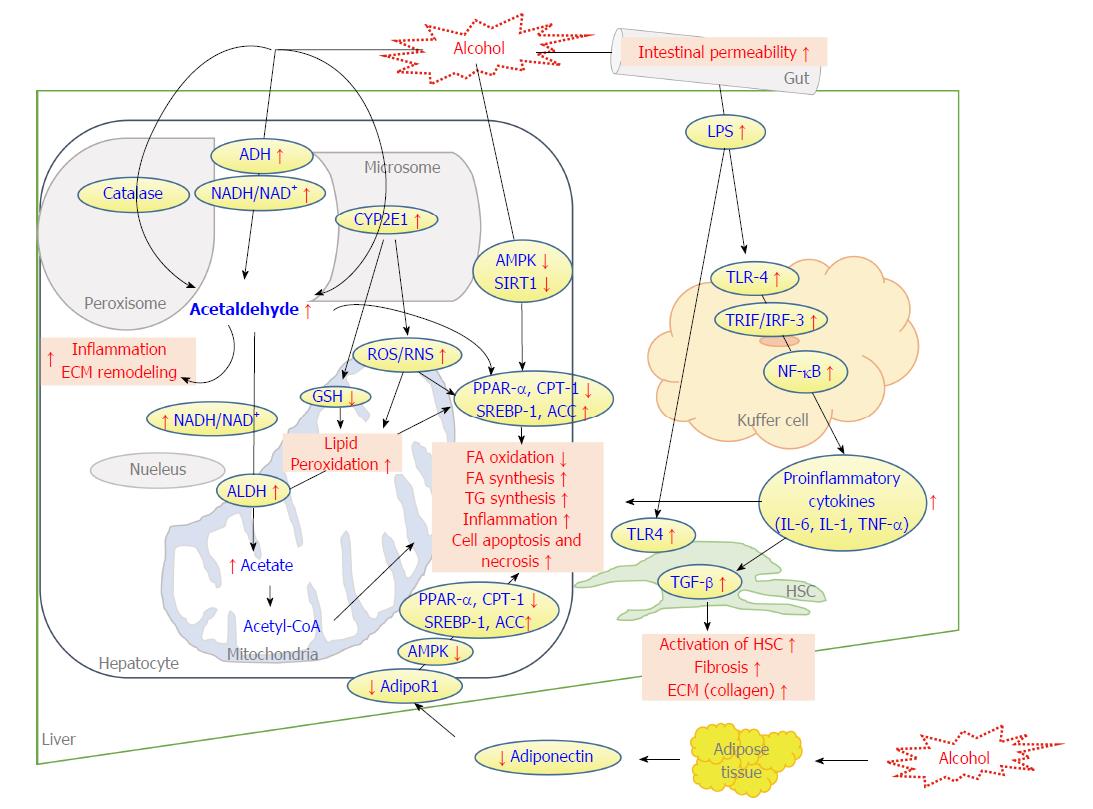Copyright
©The Author(s) 2016.
World J Gastroenterol. Jan 7, 2016; 22(1): 8-23
Published online Jan 7, 2016. doi: 10.3748/wjg.v22.i1.8
Published online Jan 7, 2016. doi: 10.3748/wjg.v22.i1.8
Figure 1 The molecular mechanisms of alcohol-related liver pathogenesis and therapeutic targets.
Adapted from references[8,13,159]. When alcohol intake is chronic and heavy, alcohol oxidation occurs via cytochrome P450s, resulting in increased levels of CYP2E1, which in turn causes oxidative stress through the generation of ROS which are responsible for lipid peroxidation and alcoholic liver injury. ROS also negatively regulates the activation AMPK and leads to overexpression of SREBP-1, resulting in an increase of de novo lipogenesis. GSH also has been reported to its depletion by CYP2E1 followed by the development of oxidative stress. Alcohol consumption negatively affects adiponectin secretion from adipocytes then causes inactive AMPK pathway, leading to elevated de novo lipogenesis and inflammatory process in the liver, while simultaneously decreasing fatty acid β-oxidation and contributing to hepatocyte necrosis. The red font indicates the end-point of pathology in the liver. ACC: Acetyl-CoA carboxylase; ADH: Alcohol dehydrogenase; AdipoR1: Adiponectin 1; ALDH: Acetaldehyde dehydrogenase; AMPK: 5’ adenosine monophosphate-activated protein kinase; CYP2E1: Cytochrome P450 2E1; CPT-1: Carnitine palmitoyl-transferase-1; ECM: Extracellular matrix; FA: Fatty acid; GSH: Glutathione; HSC: Hepatic stellate cells; IRF-3: Interferon regulatory factor 3; IL-6/IL-1: Interleukin 6 and 1; LPS: Lipopolysaccharide; NADH/NAD+: Nicotinamide adenine dinucleotide hydrogen, nicotinamide adenine dinucleotide; NF-κB: Nuclear factor kappa; ROS: Reactive oxygen species; RNS: Reactive nitrogen species; PPAR-α: Peroxisome proliferator-activated receptor-α; SIRT1: Sirtuin 1; SREBP1: Sterol regulator element binding protein 1; TG: Trigylcerides; TLR-4: Toll-like receptor 4; TNF-α: Tumour necrosis factor-α; TGF-β: Tissue growth factor-β.
- Citation: Kim MS, Ong M, Qu X. Optimal management for alcoholic liver disease: Conventional medications, natural therapy or combination? World J Gastroenterol 2016; 22(1): 8-23
- URL: https://www.wjgnet.com/1007-9327/full/v22/i1/8.htm
- DOI: https://dx.doi.org/10.3748/wjg.v22.i1.8









